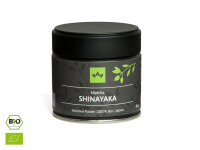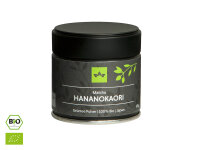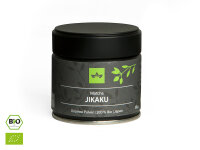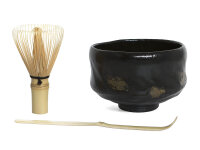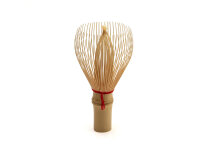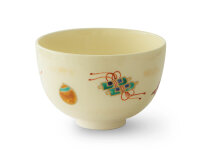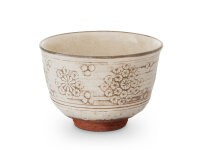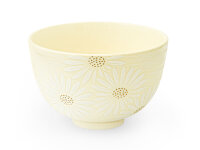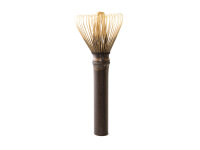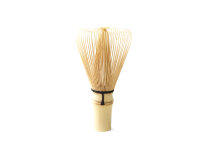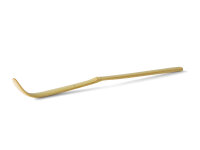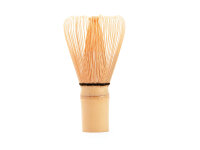Matcha
THE MAGIC OF NATURE IN A TEA POWDER
Matcha - The Green Tea Powder from Japan
The bitter-sweet, dark green Matcha is the most important and at the same time the strangest among Japanese green teas. Not only in the tea ceremony, but also in meditation and as a cool summer refreshment, it has become indispensable in Japan and has already become a trend in Europe as well. What makes this extraordinary drink so successful?
Table of contents
Unmatched in Health Benefits
Drinking Matcha can lead to a longer life: At least, tea can help prevent diseases and improve fitness. The Ohsaki study in Japan in 2006 demonstrated the lasting positive effect on the cardiovascular system. This effect unfolds with regular consumption of green tea, preferably several cups a day. This is mainly due to the secondary plant substances contained, which act as natural defenses for the body. We already know that the "superfood" green tea contains a lot of antioxidants, the amino acid L-Theanine, and other valuable ingredients that keep the body young, healthy, and alert. But Matcha can provide all of this in multiple times the amount - because here you drink the tea leaf directly. This is because during production, the tea leaves are traditionally ground into powder with millstones and dissolved directly in water. That's why the Japanese characters for Matcha, 抹茶, simply mean "ground tea."
This way, you can absorb every healthy ingredient and benefit many times over: Japanese Matcha tea contains about ten times as many antioxidants such as zinc, magnesium, and vitamins A and C as other green teas, such as Sencha, for example. They in turn have a positive effect on cell health by protecting against so-called free radicals. Additionally, Matcha tea grows in Japan just before harvest in the shade of bamboo or cloth mats. This naturally gives it a particularly high concentration of chlorophyll, a first-class detoxifier - more than any other type of tea. The shade also gives it its characteristic bittersweet umami flavor.
Even when it comes to losing weight, drinking Matcha tea can help: By stimulating metabolism and curbing appetite at the same time, it can initiate more efficient calorie burning. According to studies, the catechins found in Matcha in high concentration make it easier to burn fat and lose weight faster. The combination of caffeine and other ingredients provides healthy energy for the day without burdening the body by raising blood pressure. Because the caffeine content is only about 25 percent, it's not as high as in a cup of coffee - with a similar effect.
Finally, the green powder can have a positive effect on concentration and cognitive performance. This is appreciated not only by learners and workers in Japan but traditionally also by monks.
A Celebration for a Bowl of Tea
Buddhist monk Myoan Eisai brought both tea and Zen from China to Japan, spreading what is now so inherently Japanese. For nearly 1000 years, it has been a part of Zen Buddhist meditation in Japan to drink a bowl of Matcha tea. The first green tea of this kind was cultivated in the Uji region near Kyoto. Even today, Matcha from producers in this area is considered particularly high-quality. Another important cultivation region for the finest Matcha is the rural city of Nishio, located in the heart of the main island of Honshu in Japan.
On these Japanese fields, Tencha is grown, as the leaf is called before being ground into the finest powder. Unlike other varieties, Tencha is roasted and dried but not kneaded, so the tea leaf remains intact. As a result, while the entire leaf would not have a good taste when brewed regardless of quality, when ground, it unfolds its aroma even more.
A few sips of Matcha tea help to keep the mind awake and mindful during long meditation sessions and were originally ritually drunk in front of sacred statues. Today, temple residents distribute tea bowls along with a small sweet (Wagashi) to each participant after a Zen meditation. Matcha expresses the essence of Zen: aesthetics of simplicity, celebration of the moment, and tranquility in peace. From this, the Japanese tea ceremony emerged in the 16th century.
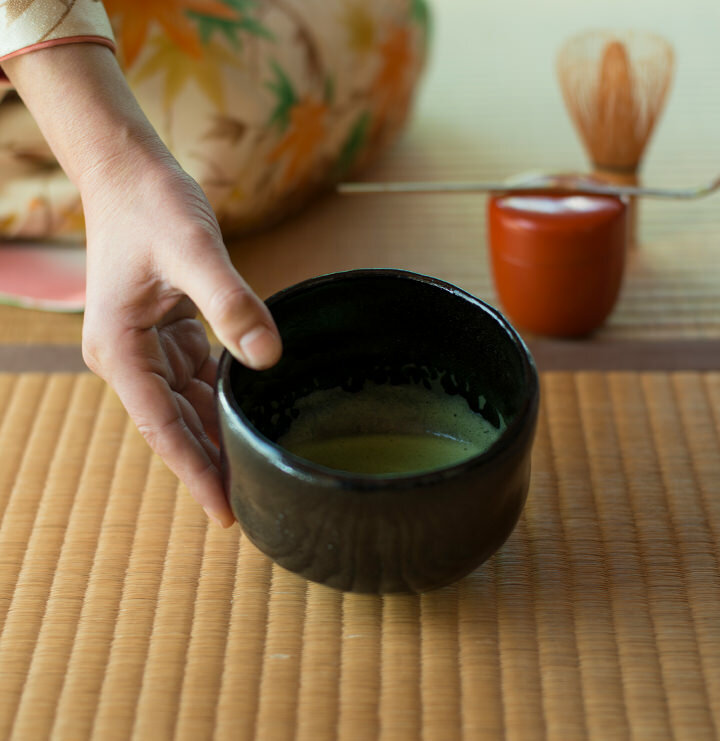
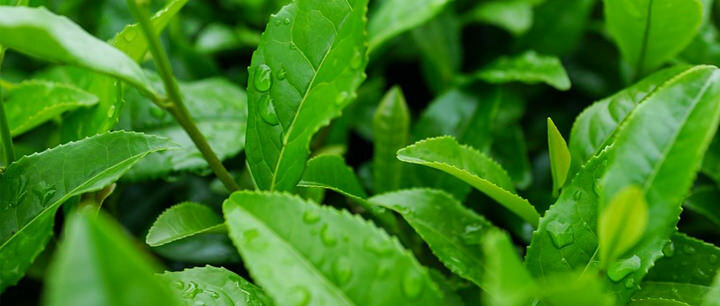
If you participate in such a ceremony, you should know how to properly enjoy the green tea. First, consume the Wagashi and use the provided paper to clean your mouth and hands. Then, pick up the tea bowl and rotate it twice clockwise so that you don't touch the decorated side of the bowl with your mouth. Hold the bowl with your right hand on the side and support it from the bottom with your left hand. Drink the Matcha tea in three to four sips. Before returning the bowl, rotate it counterclockwise again. Don't forget to thank the host afterward and compliment how delicious the tea was.
Which Matcha Do You Drink?
Aside from many formal and aesthetic rules, the preparation itself is ceremonial. The quality of the tea plays an important role in this process. There are different types of Matcha tea suitable for various recipes, varying in color, texture, processing, fineness of the green tea powder, and aroma. Inexpensive varieties are obtained from the stems rather than the leaves of the tea plant. With every Matcha powder, it should smell fresh and slightly grassy, and feel fine and soft. The culinary grade is the most affordable, tastes good in many dishes and drinks like Matcha lattes, and is perfect for baking. Its flavor is strong and slightly bitter, so many people prefer to sweeten this tea before drinking. For enjoying Matcha in its pure form, the classic ceremonial grade is recommended. This sweeter and milder powder requires no additives and can be recognized by its bright green color and fine texture. Although this type of green tea is slightly more expensive and available in smaller packages, its quality and taste are unparalleled.
Apart from tea and pot, one also uses the following accessories:
- Chawan: The tea bowl from which the tea is drunk
- Chasen: The bamboo whisk used for whisking Matcha tea
- Chashaku: A thin bamboo spoon for measuring Matcha powder
- A small sieve for refining the powder
- Hishaku: A ladle for pouring water
- Natsume: Decorative container for Matcha tea powder
- Chakin: A cloth for ceremonially cleaning the utensils
Tea bowls, Chasen, and Chashaku are usually available in matching sets. These are indispensable for an authentic tea experience. Ground green tea can be enjoyed the longest when stored airtight in a container and refrigerated.
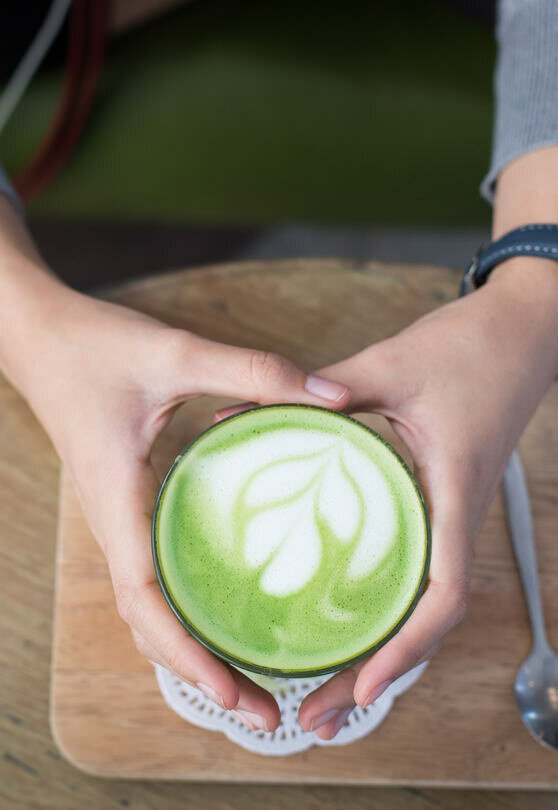
Prepare Special Green Tea Traditionally and Deliciously
There are two ways to prepare Matcha tea properly: thin Usucha and thick Koicha, which is almost like eating. The first option is the most common and is also suitable for Matcha beginners as it is not as intense in flavor. For this, mix about half (for best quality) to one teaspoon (1.75 grams) or two Chashaku green tea powder with 180 ml hot water (about one bowl).
First, boil the water and then let it cool for about 5-10 minutes. This will achieve an optimal temperature of 80-90 degrees Celsius; particularly high-quality Matcha tea can also be enjoyed at 70 degrees Celsius. Put the Matcha powder into the tea bowl, preferably through a fine mesh sieve to dissolve any possible lumps. Then, add about 60 ml of water and mix the mixture with the bamboo whisk. Now add the rest of the water and whisk the Matcha in a W-shape with the bamboo whisk in the Matcha bowl until frothy.
For Koicha, on the other hand, you will need five Chashaku tea powder instead of two, so about 2.5 teaspoons or 3.75 grams of Matcha, for 30 ml of water. For a summery, ice-cold indulgence, prepare the Matcha tea according to the instructions, but you will need cold water and only half the amount of Matcha powder (about 1 gram or half a teaspoon). After whisking with the bamboo whisk, simply add more water (up to about 300 ml) and adjust the drink to taste with honey, cane sugar, or other sweeteners of your choice. After a few attempts, you can adjust the Matcha-water ratio in the recipe according to your preferences. For cooking and baking, the rule of thumb is: one teaspoon of Matcha powder per serving. But here too, experimentation is possible according to your preferences.
When preparing and enjoying a bowl of Matcha, proceed carefully, mindfully, and with flowing movements to approximate the feeling of the tea ceremony. Well-prepared and lovingly made Matcha tea can be recognized by its consistency. Then it won't taste so bitter and can unfold its invigorating effect optimally. Discover the complex aroma that lingers on the tongue for a long time – similar to a good wine.
The Sweet World of Matcha
If pure Matcha tea is still a bit too acquired for some, they can still enjoy this green tea in countless products offered by Japan's confectionery industry. Because green tea is a popular ingredient and simply delicious: for example, in cakes, muesli, ice cream, crepes, donuts, cookies, chocolates, candies, and the famous KitKat. Matcha latte is available in every café, and not only cocktails but also beer are enriched with it. Even German Baumkuchen is reinterpreted with the green tea powder. So there is something for everyone.
But not only sweet, savory dishes can also be inspired by Matcha: Limited editions of instant ramen and green soba (buckwheat noodles in a broth) in some restaurants rely on the Japanese love for Matcha tea. Or you don't even have to eat or drink it: The green tea is often included in face masks and other skincare products.
The imagination knows no bounds. This proves that Matcha doesn't necessarily have to be limited to tea ceremonies. Since the Edo period (1603-1867), anyone in Japan can enjoy Matcha tea, regardless of their social status. This type of tea plays a special role in tea culture due to its unique characteristics, benefits for well-being, and symbolic meaning. Every vending machine in Japan offers bottles of green tea, whether chilled or warm, refreshing in the summer heat and warming from the inside in winter. Let Matcha into your everyday life, into your tea breaks, your smoothies, your cakes - and benefit from its fantastic effects.




